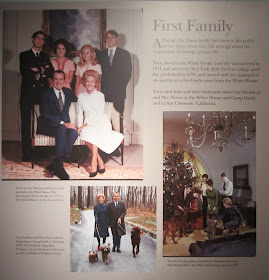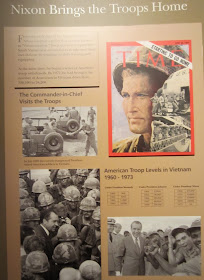Richard Nixon's combination of brilliance and paranoia makes him, at least for me, one of the most fascinating politicians in America's history. On a recent visit to the Richard Nixon Presidential Library in Yorba Linda, California, I learned a lot more about Nixon's career.
There were a lot of things that happened during the Nixon administration are part of my memory bank,
Now that we are 40 years past the end of Nixon's Presidency, it was also interesting to see him in an historical context:
The museum has a lot of information about Nixon's youth:

After passing the California Bar, he joined a firm back home in Whittier:
During World War II, he joined the Navy. Although he saw no combat, he earned two service stars:
He returned home and in 1946 was elected to his first political office: U.S. Congressman. In 1950 he was elected to the U.S. Senate, and in 1952 he joined Dwight Eisenhower as his candidate for Vice President. They were an odd couple, but they were elected and served together for two terms.
He was not deterred, however, and soon began to think about another attempt:
In 1968, he defeated George Romney in the 1968 Presidential primaries:
. . . and then defeated Democratic Vice President Hubert Humphrey and Independent George Wallace to win the Presidency:
I love this bit of needlework that is on display in the 1968 Presidency section of the museum. It was sewn by Julie Nixon for her father:
I think this quote from his First Inaugural Address is quite beautiful:
I remember Nixon as being very aggressive in foreign policy:
Nixon and Chou en-Lai in China, February 1972:
Meanwhile, a lot was going on at home. I will always remember the weddings of his two beautiful daughters at the White House, Julie to the grandson of President Eisenhower in 1968, and Tricia to Harvard law grad Edward Cox in 1971. The Nixons were an idyllic American family. Almost.
I guess it started to fall apart in the 1972 campaign for re-election, although we didn't know it at the time.
It was a landslide victory for Nixon:
He went right back to work on some troublesome domestic issues:

These problems were coming via Walter Cronkite into all of our living rooms (including mine, where my mother was a faithful watcher):
There were a lot of things that happened during the Nixon administration are part of my memory bank,
Reproduction of a spacesuit worn in the last Apollo mission to the moon in 1972

Although he was offered a tuition grant to Harvard University, Dick stayed home to help with the family business and went to Whittier College. Here he is, a substitute on the college football team (middle guy on the back row):
After graduating, he was awarded a full-tuition scholarship to Duke University, where he excelled, was President of the Duke Bar Association, was inducted into the Order of the Coif, and graduated third in his class.After passing the California Bar, he joined a firm back home in Whittier:
During World War II, he joined the Navy. Although he saw no combat, he earned two service stars:
Nixon was a very active Vice President. He made several key political trips, including this 1953 trip to the Far East:
In 1959, Nixon attended the American National Exhibition held in the Soviet Union in Moscow. Nixon toured the American exhibit, "a typical American house that the average American citizen could afford," with Soviet Premier Nikita Khrushchev. While standing in the kitchen area, reproduced in the museum, Nixon and Khrushchev had an impromptu discussion of the merits of capitalism versus communism that has come to be known as "The Kitchen Debate."
Nixon's first campaign for President in 1960 was unsuccessful:
Too bad Pat didn't run:He was not deterred, however, and soon began to think about another attempt:
In 1968, he defeated George Romney in the 1968 Presidential primaries:
. . . and then defeated Democratic Vice President Hubert Humphrey and Independent George Wallace to win the Presidency:
I love this bit of needlework that is on display in the 1968 Presidency section of the museum. It was sewn by Julie Nixon for her father:
Nixon and Chou en-Lai in China, February 1972:
In May of that year, Nixon visited Soviet Premier Brezhnev in Moscow to work out a nuclear arms agreement. Nixon had the good sense to name Henry Kissinger, a man whose opinions on foreign policy are still valued today, as his National Security Advisor AND his Secretary of State:
Meanwhile, a lot was going on at home. I will always remember the weddings of his two beautiful daughters at the White House, Julie to the grandson of President Eisenhower in 1968, and Tricia to Harvard law grad Edward Cox in 1971. The Nixons were an idyllic American family. Almost.
I guess it started to fall apart in the 1972 campaign for re-election, although we didn't know it at the time.
It was a landslide victory for Nixon:

These problems were coming via Walter Cronkite into all of our living rooms (including mine, where my mother was a faithful watcher):
Nixon also continued to work on issues abroad, finishing what he had started in Vietnam:
In October 1973, Nixon sent supplies to Israel that helped them win the Yom Kippur War:
However, just six months into his second term, the Watergate hearings began, and everything Nixon had built began to unravel.
Next: Nixon Presidential Library Part 2, Nixon's Legacy.

























.JPG)


















This presidential library is one of my favorites. He was in during a momentous time in world affairs and I think did a pretty good job. His paranoia got him in trouble.
ReplyDelete